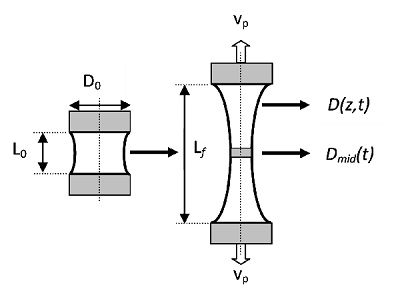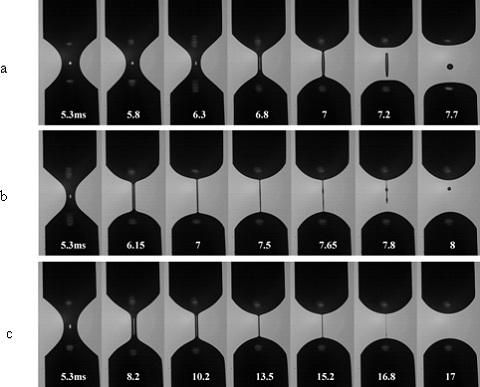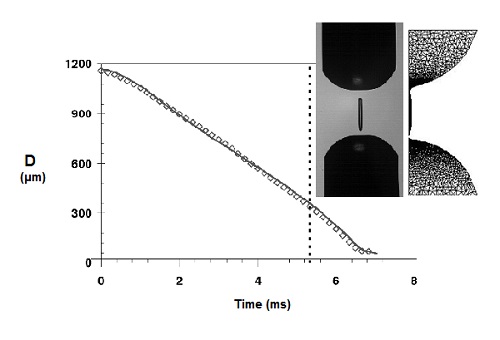The Cambridge Trimaster
The Cambridge Trimaster is a device for investigating the extensional behaviour of low viscosity fluids. It probes the extensional and non linear rheology of such fluids using aspects of capillary thinning rheometers [Orr and Sridhar (1999); Anna et al. (1999)]. The method consists of imposing an initial rapid extensional step strain to a given volume of fluid to create liquid bridge, which then subsequently self-thins under the action of viscous, elastic and capillary forces (Fig. 1). The transient Hencky strain can be calculated by the rate of thinning of the mid-filament diameter with time.
| Figure 1: Principle of the capillary thinning rheology; [Vadillo et al. (2010)]. |
Trimaster Mk2
For low viscosity fluids it is difficult to use classical filament stretch apparatus such as CaBER [Anna et al. (1999)] due to the short time it takes for the filament to break after the pistons cessation of motion. The Cambridge Trimaster was specially developed to overcome these technical limits. It can perform fast stretching, using individual piston velocities (vp) of up to 75 mm/s (combine piston velocity (U) = 150 mm/s), over a distance of 10µm to 10cm of filament of fluids. The filament is initially positioned between to identical pistons. These pistons are attached to a band and a slider enabling them to move in the symmetrically in the opposite direction while maintaining the centre of the thread in a steady position (Fig. 2).
| Figure 2 - Schematic diagram (a) and photograph (b) of the Trimaster Mk2 |
The filament stretching and thinning profiles are recorded using a high speed camera (Photron Fastcam 1024 PCI) and photographs of the whole filament profile as a function of time are obtained. This apparatus enables interrogation of the drop formation process of low viscosity low viscoelasticity with very well defined boundary conditions. Examples of the filament thinning profiles obtained are shown below (see Fig. 3).
|
|
| Figure 3 - Transient profiles recorded using the Trimaster Mk2: (a) Diethyl Phthalate and (b) Diethyl Phthalate + 0.5wt% of monodisperse polystyrene (MWt = 110k) and (c) Diethyl Phthalate + 1wt% of monodisperse polystyrene (MWt = 110k). D0 = 1.2mm, L0 = 0.6mm, Lf = 1.4mm and U = 150mm/s; [Vadillo et al. (2010)]. |
Example: Polystyrene solutions in diethyl phalate
For diethyl phthalate (DEP), a low viscosity Newtonian fluid (Oh < 7.23-1, [Rodd et al. (2005)]), the filament has the form of a cylinder when the pistons stop (5.3ms) and conserves this shape until 6.8ms. The filament loses its uniform shape with faster thinning points located on its top and bottom, eventually ending by two clear break up points and the formation of a unique droplet (Fig. 3a).
The addition of polymer, as well as increasing the base viscosity, adds an extra stress in the filament that acts against the surface tension to stabilise the filament. This results in forming a thinner long lasting filament along which droplets can develop (Fig. 3b). Further increase in polymer content leads to a thinning mechanism fully controlled by the fluid elasticity, which prevent the formation of droplets on the filament. The filament remains cylindrical until the end and breaks up (Fig 3c).
The mid-filament evolution has been found to be linear in the Newtonian case of the DEP, while addition of polymer results in exponential decrease typical of viscoelastic fluid. It was then possible to extract extensional relaxation time and values from hundredth of microseconds to millisecond have been measured. The extensional relaxation times experimentally determined in this way appear to be several order of higher than previously extracted from the linear viscoelastic measurements using the Zimm model. Such result has only been reported in the literature once in the work of [Clasen et al. (2006)].
The mid-filament strain rate can be related to the fluid transient apparent extensional viscosity via equation [McKinley and Tripathi (2000)]:
where ηE is the apparent extensional viscosity, σ is the fluid surface tension, Dmid is the filament mid filament and X is a shape factor comprises between 0.5 and 1 with 1 corresponding to a perfect cylinder. Addition of polymer increases the fluid apparent extensional viscosity and can reach ηE/η0 of about 250 in the case of 5wt% PS110 in DEP (Fig. 4).
|
|
| Figure 4 - The transient extensional rheology of DEP solutions as a function of relaxation Hencky strain for different PS concentrations. Initial distance 0.6mm, final distance: 1.4mm, combined piston velocity: 150mm/s. The lines are obtained from the exponential fitting of the evolution of the thinning of the diameter. The geometrical factor “X” is fitted using the experimental data at low Hencky strain. (♦) DEP, (■) DEP-0.5wt% PS110, (▲) DEP-1wt% PS110, (○) DEP-2.5wt% PS110, (+) DEP-5wt% PS110; [Vadillo et al. (2010)]. |
The perfectly defined and controlled boundary conditions enable comparison of the filament break experiments with numerical simulation. Here, the numerical simulations have been developed in the School of Mathematics in Leeds University by Dr. Oliver Harlen. Several constitutive equations are available to include the polymer influence including Oldroyd-B, FENE-Cr or FENE-P.
| Figure 5 - Comparison between (◊) experimental and (-) simulated mid filament evolution. Experimental and simulated transient profiles are visible in insert. η* = 14mPa.s, σ = 37mN/m, ρ = 1120 kg/m3, D0 = 1.2mm, L0 = 0.6mm, Lf = 1.4mm and U = 150mm/s. |
Simulations of filament stretching using Newtonian fluids are in excellent agreement with experimental observation. However, simulations of filament thinning of sample containing polymer are not giving satisfactory agreement with experimental observation. Figure 6 presents comparison between numerical simulations and experimental measurements in the case of DEP + 2.5 wt%.
| Figure 6 - Comparison of the mid-filament evolution in the case of DEP + 2.5wt% PS110 for (+) experiments and (▬) Fene-CR 1 mode λ = 30 µs and g = 630 Pa, (▬) Fene-CR 1 mode λ = 1ms and g = 17 Pa and (▬) Oldroyd-B 1 mode sλ = 1 ms and g = 17 Pa. ηs = 13.9 mPa.s, η0 = 31 mPa.s, σ = 37 mN/m and ρ = 1050 kg/m3. |
The results demonstrate that the experimentally extracted relaxation time for both Fene-CR and Oldroyd-B constitutive equations enable predicting the elasto-capillary thinning phase, although between 6 and 10 ms the predicted mid-filament diameter is significantly larger than the experimentally observed one. In both cases the break-up is not correctly reproduced although one must notice that, in Oldroyd-B case, the simulation has been stopped due to the large number of grid points. In term of full transient profile, Oldroyd-B constitutive equation represents the long lasting cylindrical filament probably due to the infinite extensibility of the polymer chain, whereas Fene-CR demonstrates a low viscosity Newtonian like break-up. The polymer chain extension plays a role that need to be determined. Using the longest Zimm relaxation time extracted from the PAV LVE data as an input gives a good agreement between 5 and 7 ms, it cannot satisfactory represent the filament long time behaviour. An approach based on a single mode model may not be sufficient to describe properly the full process even for dilute polymer solutions and that a multi-mode model may be needed to better represent the behaviour at short and at long times.
Investigations using the Trimaster led to the development of the Trimaster HB4, an instrument for investigating filament break up at high speeds.
References
Anna, S. L., C. Rogers, and G. H. McKinley, “On controlling the kinematics of a filament stretching rheometer using a real-time active control mechanism,” J. Non-Newtonian Fluid Mech. 87, 307–335 (1999).
Clasen, C., J. P. Plog, W.-M. Kulicke, M. Owens, C. Macosko, L. E. Scriven, M. Verani, and G. H. McKinley, “How dilute are dilute solutions in extensional flows?” J. Rheol. 50(6), 849–881 (2006).
Orr, N. V., and T. Sridhar, “Probing the dynamics of polymer solutions in extensional flow using step strain rate experiments,” J. Non-Newtonian Fluid Mech. 82, 203–232 (1999).
Rodd, L. E., T. P. Scott, J. J. Cooper-White, and G. H. McKinley, “Capillary breakup rheometry of lowviscosity elastic fluids,” Appl. Rheol. 15(1), 12–27 (2005).
Vadillo D.C., T. R. Tuladhar, A. C. Mulji, S. Jung, S. D. Hoath and M. R. Mackley, “Evaluation of the inkjet fluid’s performance using the “Cambridge Trimaster” filament stretch and break-up device”, J. Rheol, 54(2), 261-282 (2010)







